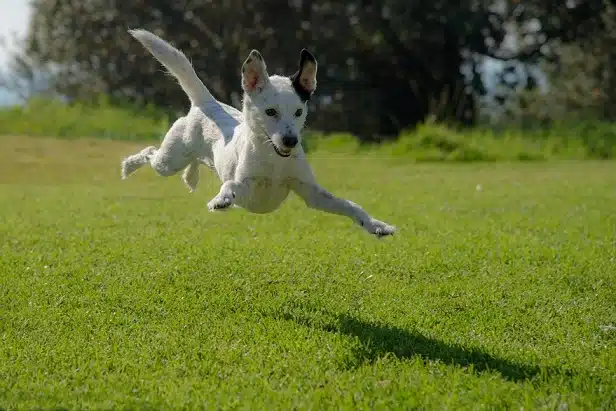Does your dog keep jumping the fence despite your best efforts? This is more than just a frustrating behavior—it can be dangerous. Dogs that escape from their yards risk traffic accidents, fights with other animals, or becoming lost. Whether you own a high-energy breed like a German Shepherd (which can run up to 30 mph!) or a curious mixed breed, it’s crucial to understand how to keep a dog from jumping the fence and implement long-term solutions that are both safe and effective.
Why Dogs Jump or Climb Fences
- Boredom: Lack of stimulation leads to fence-jumping adventures.
- Separation anxiety: Dogs may try to reach their owner or escape from loneliness.
- Prey drive: A rabbit, squirrel, or neighborhood cat can trigger instant pursuit mode.
- Territorial behavior: Some dogs feel the need to guard beyond their boundaries.
- Fear or stress: Loud noises or strange scents can provoke flight behavior.
If you’re curious about how far a dog can roam once out, some dogs may travel miles. This guide for outdoor cats shows a similar roaming pattern among unsupervised pets.
Physical Solutions to Prevent Dog Fence Escapes
A. Improve Your Fence
One of the most effective ways to prevent a dog from jumping a fence is to alter the fence itself:
- Add height using lattice panels or wooden extensions.
- Install inward-angled lean-ins or L-footers to discourage climbing.
- Use solid materials or plant shrubs to block visual triggers and provide privacy for chain link fences.
- Rollers or anti-climb tops (like coyote rollers) make it harder to scale the fence.
Looking for a cheap way to keep a dog from jumping the fence? Zip-tying PVC piping along the top edge can create a slippery surface that deters climbers.
B. Eliminate Launch Points
Remove items near the fence that dogs could use to gain a height advantage:
- Wood piles
- AC units
- Patio furniture
This is especially important if your dog is a jumper. If you’ve ever Googled “how fast can a German Shepherd dog run”, you know how athletic some breeds can be. Reducing take-off points is critical.
Behavioral and Training Strategies
A. Obedience Reinforcement
Train your dog to respect boundaries:
- Practice commands like “stay,” “come,” and “leave it.”
- Use positive reinforcement with treats and praise.
- Work near the fence line to build reliability.
B. Structured Outdoor Time
Avoid unsupervised yard time until the behavior is under control. Gradually extend freedom once habits improve.
C. Deterrent Methods
Use remote sound devices or humane motion sensors to discourage climbing or jumping when you’re not present.
Environmental Enrichment and Exercise
An under-stimulated dog is an escape artist waiting to happen. Here’s how to stop a dog from jumping the fence by satisfying their mental and physical needs:
- Toys and games: Puzzle feeders, fetch, and hide-and-seek games in the yard.
- Daily exercise: Walks, hikes, or off-leash runs in safe areas.
- Rotating enrichment: Change up toys and games to avoid boredom.
High-energy breeds like Border Collies or Shepherds especially need this. Wondering how fast German Shepherds run? They can sprint faster than 30 mph, so a tired dog is a safer dog.

A Dog Wearing a P5 GPS Tracker Collar
Use of GPS Trackers as a Safety Net
Unlike microchips, which only help if someone finds your dog and scans it, GPS trackers offer proactive protection. If you’re comparing GPS pet trackers vs. Apple AirTags, you’ll find that pet-specific devices like the P5 offer better reliability and range.
Contact SalesConsider Containment Alternatives
A. Invisible Fences
For properties where a physical fence isn’t an option, wireless containment systems may help. However, they’re not foolproof and require training. Learn the real cost of invisible dog fences before deciding.
B. Outdoor Dog Playpens or Kennels
A secure playpen or run can be a good short-term solution for when you can’t supervise.
When to Call in the Pros
If your dog continues escaping despite all efforts:
- Consult a certified dog trainer.
- Consider veterinary help if anxiety is suspected.
- Use a combination of physical and behavioral interventions.
FAQ: How to Stop Your Dog from Jumping the Fence
Q1: How do I keep my dog from jumping the fence without making the yard feel like a prison?
Try visually soft modifications like lattice toppers or plant-based barriers, and invest in positive training instead of punishment. Give your dog plenty of mental and physical outlets to reduce the urge to escape.
Q2: Do invisible fences really work for jumpers?
They can help, but require consistent training and supervision. Some dogs may still cross the boundary, so pair it with a GPS backup like the P5.
Q3: What’s the cheapest way to keep a dog from jumping the fence?
PVC pipe rollers, inward-angled lean-ins using wood or wire mesh, or landscaping (like hedges) can all be affordable and effective options.
Q4: Will neutering my dog help stop fence jumping?
Neutering can reduce hormone-driven behavior in some dogs, especially males, but it’s not a guaranteed fix. Combine it with behavioral training.
Q5: Should I rely on a GPS pet tracker if my dog jumps the fence frequently?
Yes, especially if you’ve dealt with repeat escapes. A tracker like the P5 can notify you instantly and help recover your pet before danger arises.
Conclusion
Learning how to keep your dog from jumping over the fence takes time, patience, and a bit of creativity. By combining fence modifications, enrichment, training, and smart tools like the P5 GPS pet tracker, you can give your dog the freedom to enjoy the yard safely.
No matter how fast or clever your dog is, consistency and the right tools will help you win the long game.




